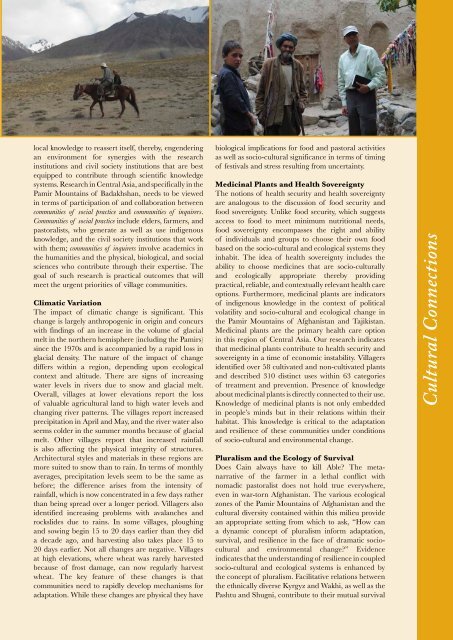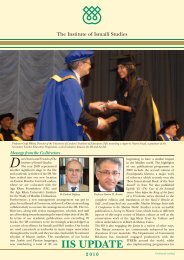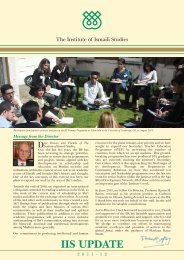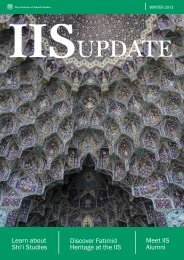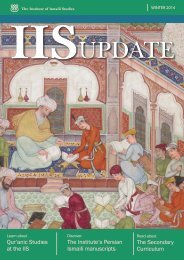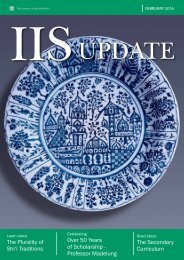IIS Alumni Newsletter 2011
Create successful ePaper yourself
Turn your PDF publications into a flip-book with our unique Google optimized e-Paper software.
local knowledge to reassert itself, thereby, engendering<br />
an environment for synergies with the research<br />
institutions and civil society institutions that are best<br />
equipped to contribute through scientific knowledge<br />
systems. Research in Central Asia, and specifically in the<br />
Pamir Mountains of Badakhshan, needs to be viewed<br />
in terms of participation of and collaboration between<br />
communities of social practice and communities of inquirers.<br />
Communities of social practice include elders, farmers, and<br />
pastoralists, who generate as well as use indigenous<br />
knowledge, and the civil society institutions that work<br />
with them; communities of inquirers involve academics in<br />
the humanities and the physical, biological, and social<br />
sciences who contribute through their expertise. The<br />
goal of such research is practical outcomes that will<br />
meet the urgent priorities of village communities.<br />
Climatic Variation<br />
The impact of climatic change is significant. This<br />
change is largely anthropogenic in origin and concurs<br />
with findings of an increase in the volume of glacial<br />
melt in the northern hemisphere (including the Pamirs)<br />
since the 1970s and is accompanied by a rapid loss in<br />
glacial density. The nature of the impact of change<br />
differs within a region, depending upon ecological<br />
context and altitude. There are signs of increasing<br />
water levels in rivers due to snow and glacial melt.<br />
Overall, villages at lower elevations report the loss<br />
of valuable agricultural land to high water levels and<br />
changing river patterns. The villages report increased<br />
precipitation in April and May, and the river water also<br />
seems colder in the summer months because of glacial<br />
melt. Other villages report that increased rainfall<br />
is also affecting the physical integrity of structures.<br />
Architectural styles and materials in these regions are<br />
more suited to snow than to rain. In terms of monthly<br />
averages, precipitation levels seem to be the same as<br />
before; the difference arises from the intensity of<br />
rainfall, which is now concentrated in a few days rather<br />
than being spread over a longer period. Villagers also<br />
identified increasing problems with avalanches and<br />
rockslides due to rains. In some villages, ploughing<br />
and sowing begin 15 to 20 days earlier than they did<br />
a decade ago, and harvesting also takes place 15 to<br />
20 days earlier. Not all changes are negative. Villages<br />
at high elevations, where wheat was rarely harvested<br />
because of frost damage, can now regularly harvest<br />
wheat. The key feature of these changes is that<br />
communities need to rapidly develop mechanisms for<br />
adaptation. While these changes are physical they have<br />
biological implications for food and pastoral activities<br />
as well as socio-cultural significance in terms of timing<br />
of festivals and stress resulting from uncertainty.<br />
Medicinal Plants and Health Sovereignty<br />
The notions of health security and health sovereignty<br />
are analogous to the discussion of food security and<br />
food sovereignty. Unlike food security, which suggests<br />
access to food to meet minimum nutritional needs,<br />
food sovereignty encompasses the right and ability<br />
of individuals and groups to choose their own food<br />
based on the socio-cultural and ecological systems they<br />
inhabit. The idea of health sovereignty includes the<br />
ability to choose medicines that are socio-culturally<br />
and ecologically appropriate thereby providing<br />
practical, reliable, and contextually relevant health care<br />
options. Furthermore, medicinal plants are indicators<br />
of indigenous knowledge in the context of political<br />
volatility and socio-cultural and ecological change in<br />
the Pamir Mountains of Afghanistan and Tajikistan.<br />
Medicinal plants are the primary health care option<br />
in this region of Central Asia. Our research indicates<br />
that medicinal plants contribute to health security and<br />
sovereignty in a time of economic instability. Villagers<br />
identified over 58 cultivated and non-cultivated plants<br />
and described 310 distinct uses within 63 categories<br />
of treatment and prevention. Presence of knowledge<br />
about medicinal plants is directly connected to their use.<br />
Knowledge of medicinal plants is not only embedded<br />
in people’s minds but in their relations within their<br />
habitat. This knowledge is critical to the adaptation<br />
and resilience of these communities under conditions<br />
of socio-cultural and environmental change.<br />
Pluralism and the Ecology of Survival<br />
Does Cain always have to kill Able? The metanarrative<br />
of the farmer in a lethal conflict with<br />
nomadic pastoralist does not hold true everywhere,<br />
even in war-torn Afghanistan. The various ecological<br />
zones of the Pamir Mountains of Afghanistan and the<br />
cultural diversity contained within this milieu provide<br />
an appropriate setting from which to ask, “How can<br />
a dynamic concept of pluralism inform adaptation,<br />
survival, and resilience in the face of dramatic sociocultural<br />
and environmental change?” Evidence<br />
indicates that the understanding of resilience in coupled<br />
socio-cultural and ecological systems is enhanced by<br />
the concept of pluralism. Facilitative relations between<br />
the ethnically diverse Kyrgyz and Wakhi, as well as the<br />
Pashtu and Shugni, contribute to their mutual survival<br />
Cultural Connections


